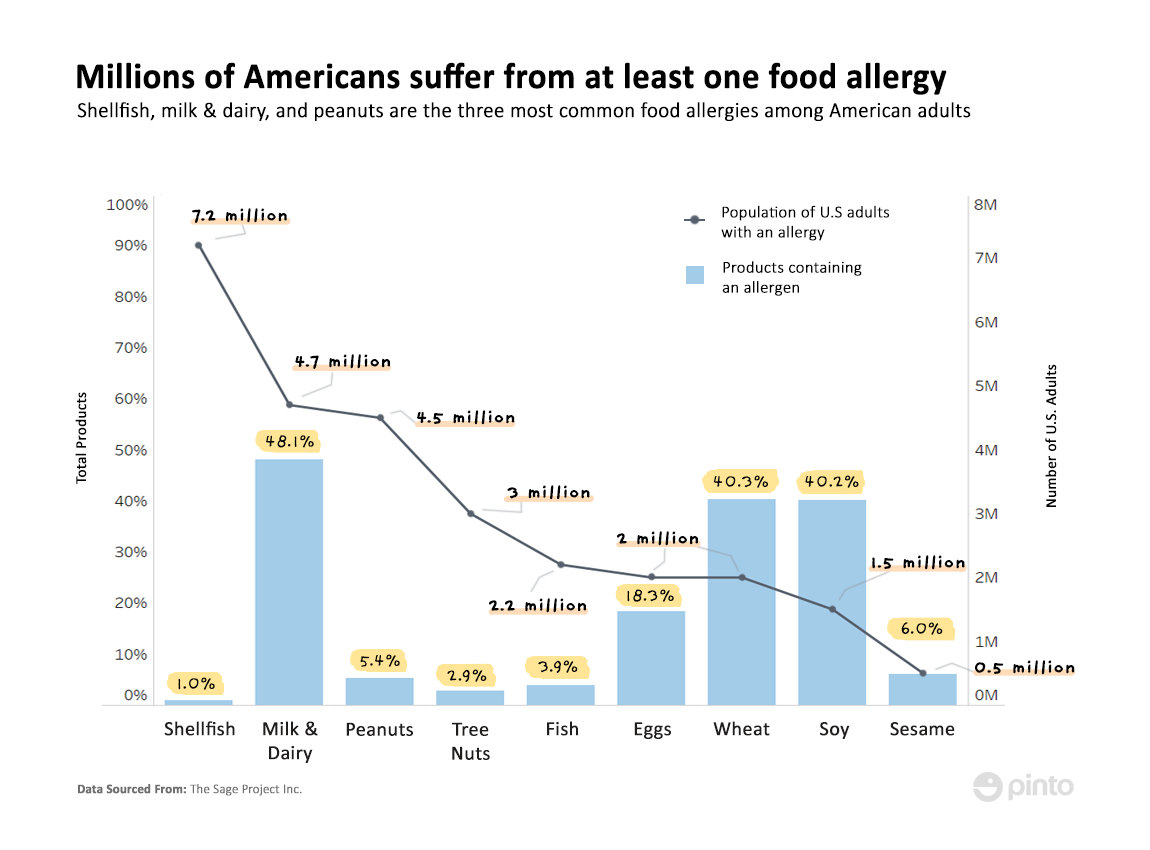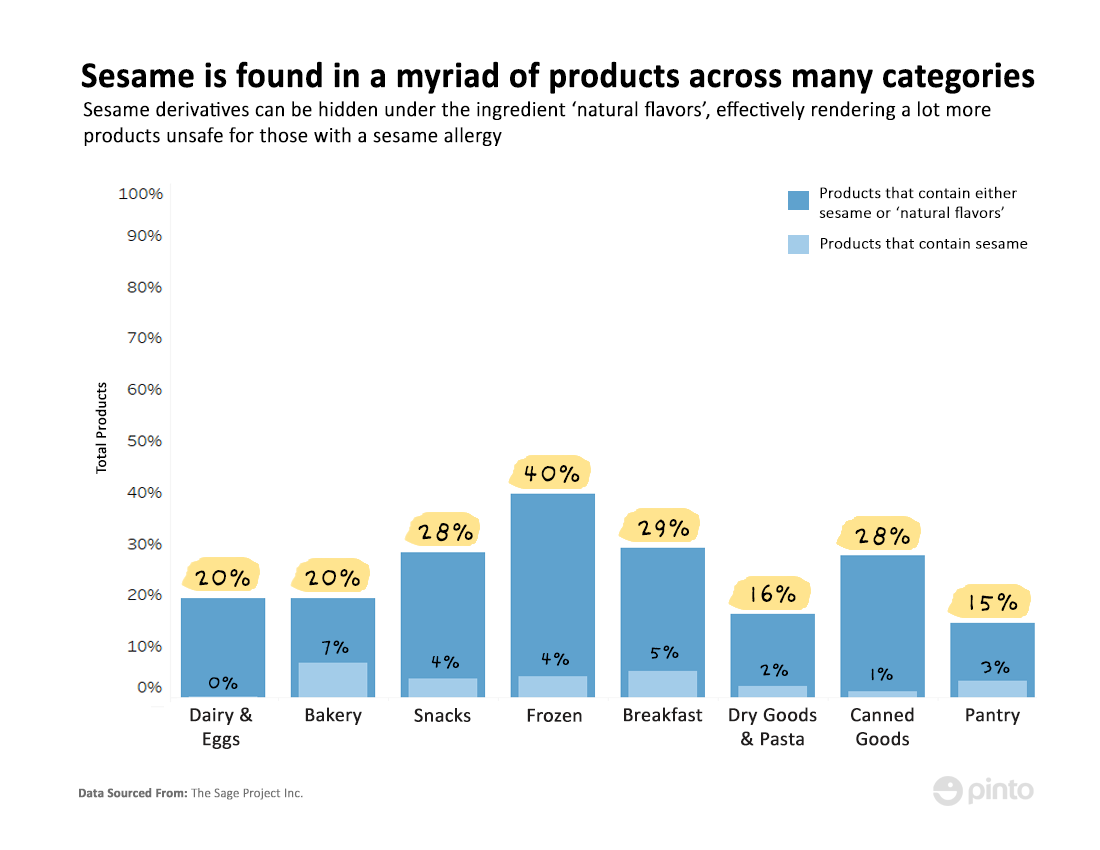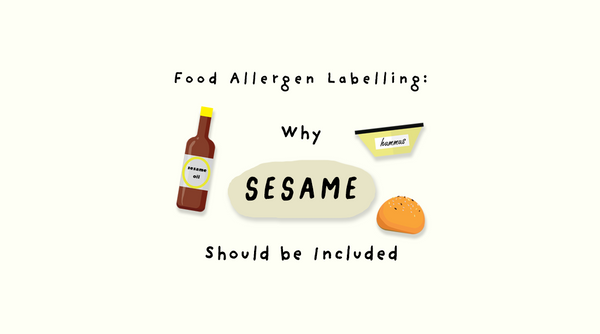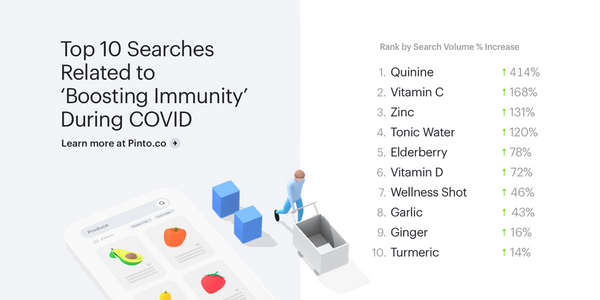A brief look
- Approximately 32 million Americans suffer from at least one food allergy.
- The prevalence of food allergies in America continues to rise every year. In the span of nine years, there has been a 377% increase in the diagnosis of anaphylactic food reactions.
- Sesame allergy is the ninth most prevalent food allergy in the U.S., and it affects around 1.5 million Americans.
- Many are encouraging the FDA to recognize sesame as a top allergen because umbrella terms like “natural flavors” make it difficult to discern if a product contains sesame derivatives.
Dive deeper
Food allergies have been rising in the U.S. at an alarming rate. Between 1997 and 2008, the rate of peanut allergies in children more than tripled. Researchers do not yet fully understand why this phenomenon is occurring, but a common theory is that changes in the bacteria in the gut (gut microbiota) have contributed to the problem. As society grows more affluent, the population begins to have higher hygiene standards, but that may counter-intuitively have an adverse impact on the human microbiota.
Some scientists believe that changes in the microbiota caused by excessive cleanliness – as well as a combination of other factors – have led to the rise in food allergies. To combat it, researchers and companies have started developing products that introduce babies to small amounts of allergens early on, hoping to lower the risk of developing food allergies.
However, the fact of the matter is that food allergies continue to affect a sizable portion of the American population, around 32 million to be exact, and the problem shows no sign of abating. In fact, between 2007 and 2016, there was a 377% increase in the diagnosis of anaphylactic food reactions. To address the issue, the FDA has stepped up efforts to ensure that the presence of allergens is clearly indicated on food labels. This includes not only whether it contains an allergen, but companies must also specify if the product has been produced in a facility where allergens are present. However, some potential allergens are not required to be listed. In the U.S., only the eight most common allergens have to be disclosed on the label. Europe and Canada disclose the top 14 and 11 allergens, respectively.
Between 2007 and 2016, a 377% increase in the diagnosis of anaphylactic food reactions was seen.
In the U.S., there is a growing consensus among experts that other allergens should be included on food labels too. Sesame is the ninth most prevalent food allergy in the country. The number of people with a sesame allergy is steadily growing, and it is estimated to affect 0.5 million American adults. To see how it stacks up against the current top eight allergens, we took a look at the prevalence of allergens in the majority of packaged products available in major U.S. grocery stores via the Pinto database and charted them alongside the prevalence of allergies in the adult U.S. population.

As pictured in the graph above, the top food allergy among Americans is shellfish while sesame allergy is the least common out of the nine. A separate study that looked at both adults and children determined that about 1.5 million Americans have a sesame allergy. In Europe, Canada, and Australia, efforts are already underway to add sesame to the list of allergens that must be declared on food labels.
In the U.S., the labels on products that contain tahini or hummus (both of which are made with sesame) are not required to specifically mention that the product contains sesame.
In Europe, Canada, and Australia, efforts are already underway to add sesame to the list of allergens that must be declared on food labels.
In our data from the graph above, we take into account all known sesame-containing ingredients and that brings the percentage of total products that contain sesame to 6%. But even that might not be the true number because sesame derivatives may be included in the product without being listed on the label.
Sesame derivatives may be hiding under umbrella terms
Manufacturers are currently allowed to list any ingredient that has been derived naturally under the umbrella term of “natural flavors.” Ingredients such as sesame oil or sesame flavoring can be listed as natural flavors, which leads to a gross underestimation of the total number of products that contain sesame. Since the FDA has yet to mandate the declaration of sesame and sesame derivatives on the ingredient label of all products, it is impossible to know if a product contains sesame without contacting the manufacturer directly.
To err on the side of caution, many people with a sesame allergy avoid products that include natural flavors on the label. This significantly limits their choices. To see the true impact, we compared and contrasted ingredient labels to see how many products contain natural flavors and/or sesame, versus those that only contain a known sesame ingredient.

From the data, we can see that across all categories, at least an additional 10% of products may have to be avoided if a shopper takes into consideration the presence of natural flavors instead of just avoiding products with a known sesame derivative. However, it is a step many are willing to take to avoid the risk of a potentially life-threatening anaphylactic reaction.
Furthermore, companies do not currently have to disclose whether sesame is present in their manufacturing facilities. For those with severe allergies, even a tiny amount of the ingredient can trigger a reaction. This causes them to avoid products within categories that tend to have sesame ingredients such as bakery (bread) and snacks (granola bars) since they are most likely made in facilities where sesame is present.
Companies that declare sesame as an allergen will be winners
In October 2018, the FDA requested input on the prevalence and severity of sesame allergies, prompting many to believe that the organization would soon require sesame to be listed as an allergen on food labels. The FDA invited the public and researchers alike to submit their comments within a 60-day period. More than a year later, no new announcements have been made on the matter.
To get ahead of the curve, some companies have already started declaring sesame as an allergen on their product labels. Companies such as General Mills currently disclose on their labels if the product contains sesame or may contain it due to being manufactured in a facility that processes sesame. Providing more complete information regarding sesame ingredients will enable companies to build a better relationship with customers who suffer from a sesame allergy. This may also encourage consumers to become more loyal to the brand as a whole as they develop greater confidence in the company’s labeling practices.
Whether or not the FDA ultimately requires sesame to be listed as an allergen, it still makes good business sense to start including it on labels now. There are currently about 1.5 million Americans who have a sesame allergy, and that number is almost certain to rise until an effective treatment or cure is developed. More thorough ingredient labels that cater to those with food allergies can improve consumer safety as well as the company’s bottom line.






